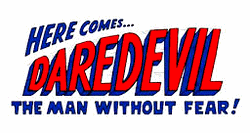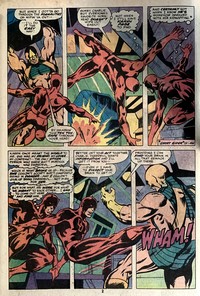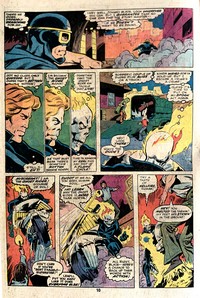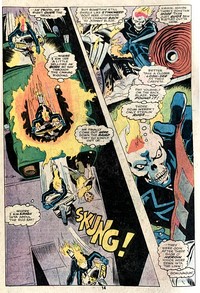 |
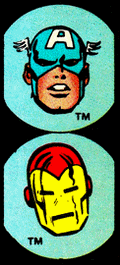 |
|
SPOTLIGHT
ON
CAPTAIN
AMERICA, IRON MAN,
DAREDEVIL
&
THE HULK
BACK
TO BACK IN A
OCTOBER
1976 MARVEL MULTI-MAGS
|
|
|
|
| |
|
| |
|
| |
|
| |
MARVEL
MULTI-MAGS |
|
Even in the early
1960s, the comic book industry
realized that in spite of the
hugely successful comeback of the
superhero genre (which had been
clinically dead for most of the
1950s) and the subsequent streak
of new creativity and the
enthusiasm it generated, its
traditional sales points were
fading away. Small stores that
had carried comic books were
pushed out of business by larger
stores and supermarkets, and
newsagents started to view the low
cover prices and therefore tiny
profit margins comics had to
offer as a
nuisance. Many ideas on how
to turn these developments around
were put forward by different
publishers, but the most
successful concepts strived to
open up new sales opportunities
and markets and thus tap into a
new customer base.
|
|
|
|
| |
| One place these potential
buyers could be found was the growing number of
supermarkets and chain stores. But in order to be able to
sell comic books at supermarkets, the product would have
to be adjusted. |
| |
| Handling
individual issues clearly was no option for these
outlets, but by looking at their logistics and
display characteristics, DC Comics (who came up
with the Comicpac concept in 1961) found
that the answer to breaking into this promising
new market was to simply package several comic
books together in a transparent plastic bag. This
resulted in a higher price per unit on sale,
which made the whole business of stocking them
much more worthwhile for the seller. The simple
packaging was also rather nifty because it
clearly showed the items were new and untouched,
while at the same time blending in with most
other goods sold at supermarkets which were also
conveniently packaged. |
|
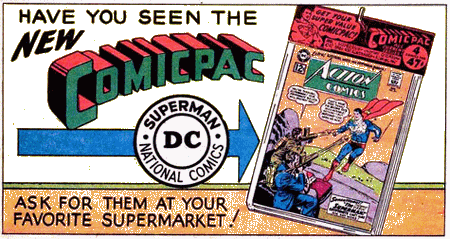 |
|
| |
| Outlets were even supplied with dedicated Comicpac
racks, which enhanced the product appeal even more since
the bags containing the comic books could be displayed on
rack hooks in an orderly and neat fashion. |
| |
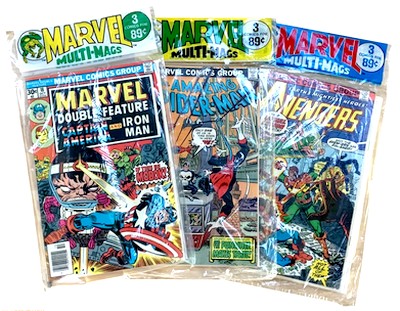
|
|
DC's
"comicpacks" were a success -
so much so that other publishers quickly
started to copy it. Marvel produced a
series of Marvel Multi-Mags in
1968/69 but then seems to have dropped
the idea again. However, by the
mid-1970s, the House of Ideas had
once again fully embraced the marketing
concept of selling multiple comic books
packaged in a sealed plastic bag to a
customer base which comic books could
hardly reach otherwise: people shopping
at supermarkets and large grocery stores.
It didn't really matter therefore that
buying these three comic books in a
comicpack for say 89¢ (rather than from
a newsagent for 90¢
in that case)
clearly presented no real bargain - it
was the opportunity and convenience to
pick up a few comics at the same time
parents and adults did their general
shopping. Neatly packaged, it almost
became an entirely different class of
commodity.
|
|
|
| |
|
| |
| The MARVEL MULTI-MAGS we are
looking at here features three titles: Marvel Double
Feature #18, Daredevil #138, and Marvel
Super-Heroes #60, all from the October 1976 cover
date run. This meant that they were actually on sale at
newsagents in July 1976, although there could be quite a
delay in terms of actual availability of MARVEL
MULTI-MAGS at some sales points, resulting in
Multi-Mags on display that contained "semi-recent
books (typically about nine months old)"
(Brevoort, 2007). Considering the packaging and
distribution process, this doesn't really seem too
surprising. This specific
three-pack is somewhat special in that it belongs
to a small number of late 1976 and early 1977 MARVEL MULTI-MAGS that came
with a yellow and green on white (3
comics for 89¢) label and display the anomaly of
not having a seal-line below the label. Heat
sealing the bag at this point served two purposes.
Firstly, it provided a somewhat strengthened label (which
of course also doubled as a hanger for most displays), but secondly - and just as importantly
- it also provided a tighter fit for the comic books, by
restricting their vertical movement inside the bag.
The lack of the sealing line below the label is in
fact a major defect with regard to how well the packaging
protects its contents, since the comic books inside a MULTI-MAGS polybag of this type are not restricted
from moving about into the label part of the sealed bag -
quite unlike those packaged inside a "regular" MULTI-MAGS polybag (i.e. with a sealed off label).
|
| |
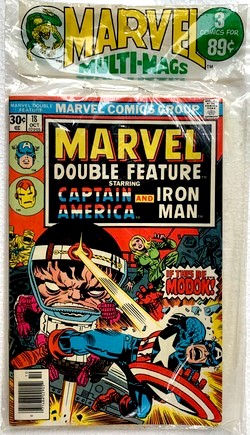 |
|
In some
cases - as the example here shows - this
protective partition was achieved (to a degree)
by the use of staples. These could have been applied by
some resellers upon delivery (or even years later
by third parties), but It is doubtful that this
took place at the original packaging facility.
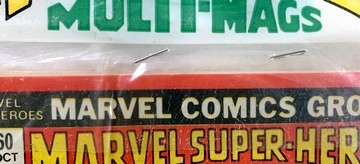
In any case, the staples did what they were
intended to do in this case and prevented any
excessive physical damage to the three comic
books inside the polybag, especially when compared
to issues that were allowed to "move
freely" in such a MULTI-MAGS.
|
|
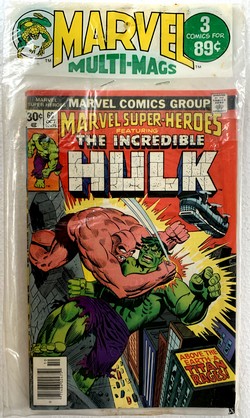 |
|
| |
| No titles had
permanent slots in the MARVEL MULTI-MAGS. The Hulk featured often and regularly, both in
his own title as well as through his reprint mag Marvel
Super-Heroes, while issues of Daredevil
would show up every now and then but on a far less
regular schedule. Marvel Double Feature,
however, was a singular rarity as this is the only known
instance, to date, of an issue of that title being packaged in a MARVEL MULTI-MAGS - the way in which individual issues
were selected for inclusion in MARVEL MULTI-MAGS does, at times, seem slightly
haphazard. But
even with regulars such as the Hulk, there was no
guarantee of an uninterrupted flow of consecutive issues
- and therefore a distinct possibility of missing out on
a part of the storyline. On top of this, the continuity
of the Marvel Universe of the 1970s was such that plots
and storylines usually evolved over more than one issue.
This didn't exactly
make the MULTI-MAGS an ideal way of getting your
Marvel comic book fix. However,
one needs to bear in mind that this was a common fate of
the average comic book reader in the 1970s Bronze Age,
whether his or her comic books came packaged in a plastic
bag or as single issues from a display or spinner rack.
Back in those days, an uninterrupted supply of specific
titles simply was not guaranteed. Not worrying too much
about possible gaps in storylines became something of a
routine - besides, you would usually get a recap of
"what happened so far" on the first page.
|
| |
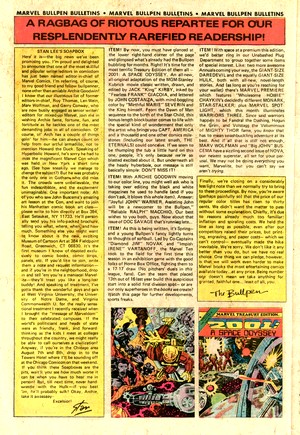 |
|
So all in
all it simply was a part of being a comic book
fan in the 1970s - as were the monthly Bullpen
Bulletins (which were the responsibility of the
editor-in-chief) and the in-house advertising
(often with mouth watering cover reproductions).
| In October 1976, the
Bullpen Bulletin was still on its way
through the alphabet as far as its title
was concerned, arriving at the letter R -
which resulted in the typically
alliterative and somewhat nonsensical
title "A Ragbag of Riotious
Repartee for Our Resplendently Rarified
Readership!". The big news -
and the headline item of Stan Lee's Soapbox
column - was the promotion of Archie
Goodwin to editor-in-chief. Lee mentioned
the "illustrious list of former
editors-in-chief, Roy Thomas, Len Wein,
Marv Wolfman, and Gerry Conway" but
diligently avoided pointing out that this
position had fast become a revolving door
affair, with those four gents
successively at the helm between 1972 and
1976, all of them stepping down to be
able to spend more time writing (with
Conway only lasting six weeks as EIC).
|
|
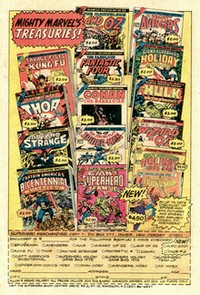 |
Also not mentioned by Stan Lee
on this occasion was the fact that Archie Goodwin
only agreed to fill the position on the
assumption that it would be temporary, until a
permanent replacement could be found; ultimately
Goodwin would resign at the end of 1977 (Howe,
2012).
|
|
| |
| As for the actual Bullpen Bulletins' various ITEM!
bullet points, they were - as usual - mostly concerned
with new and changing assignments to various writers and
artists, as well as Marvel's ever expanding line of
titles - in this case the major push was given to the
Super Treasury Edition of Kirby's 2001: A Space
Odyssey, an adaptation of the movie. It would be
followed in December 1976 by an ongoing series of the
same title which, however, would find few favours with
readers and be cancelled after a mere ten issues. The
final item of news was both bad and not really news at
all - Marvel's need (for reasons explained in this
Bullpen Bulletin in a separate box) to raise the cover
price for their regular comics to 30¢. Following a few
tests in select markets to gauge buyer reactions to the
5¢ hike, the higher price was introduced as of September
1976 (cover date), i.e. the previous month. The price for
a MARVEL MULTI-MAGS rose
accordingly, to 89¢ for three comics instead of the
previous 74¢.
|
| |
|
| |
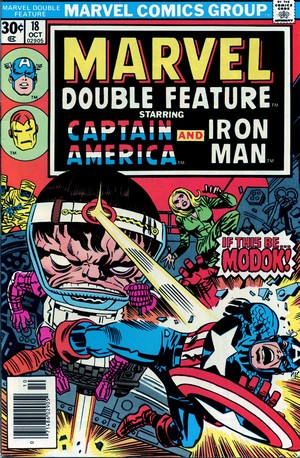
|
|
MARVEL
DOUBLE FEATURE #18
October 1976
(bi-monthly)
On Sale:
6 July 1976
Reprint
Editors - Archie Goodwin, Richard Stern
Cover - Jack Kirby (pencils) & Frank
Giacoia (inks)
"If this be...
MODOK!" (CAPTAIN
AMERICA)
(10 pages)
Story - Stan
Lee
Pencils - Jack Kirby
Inks - Joe Sinnott
Lettering -
Sam Rosen
Originally published in - Tales of
Suspense #94 (October 1967)
"Alone against
A.I.M.!" (IRON MAN)
(8 pages)
Story -
Archie Goodwin
Pencils - Gene Colan
Inks - Johnny Craig
Lettering -
Artie Simek
Originally published in - Iron Man #1
(October 1968), first 8 pages
|
|
|
| |
| Marvel Double Feature was one of Marvel's
many superhero titles of the 1970s reprinting material
from the 1960s, but stood out somewhat because it
followed the "double bill" format of Tales
of Suspense.
The
need to split one comic book between two main characters
grew out of the fact that Marvel had to use Independent
News as its distributor since the late 1950s, which by
contract limited the House of Ideas to a monthly
publishing output of only eight titles (Cooke, 1998). The
snag: unlike what the name suggested, Independent was in
fact owned by National Periodical - who also happened to
own Goodman's rivals DC Comics.
|
| |
| The well-known
outcome of this was that Stan Lee juggled
with a mix of bi-monthlies, cancelled Romance and
Western titles, and turned Horror books into
Superhero titles - all in order to get the
distribution slots freed up for what was selling
in the early to mid-1960s. Iron Man took over Tales
of Suspense and was joined by Captain
America as of issue #59 (November 1964). Marvel Double Feature,
launched in December 1973 as a bi-monthly reprint
title, followed this pattern from the start, but
for reasons only known to editorial never
actually featured Captain America and Iron Man
stories from the same issue of Tales of
Suspense.
The page count of the original material
allowed for an easy reprint, with no editing
required - up until this issue, Marvel Double
Feature #18, which featured the first 8
pages from Iron Man #1, the story of
which ran across 17 pages.
|
|
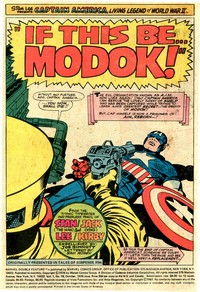 |
|
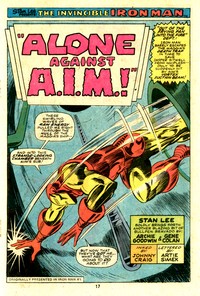 |
|
| |
| Superhero reprint titles were quite popular, since
they afforded readers access to "classic"
material which was already at the time attracting
collectors' prices for the original titles, and these
superhero reprint titles did feature fairly regularly in MARVEL MULTI-MAGS, although primarily
those reprinting Spider-Man and Hulk material. |
| |
 |
|
To date, this is
the only known instance of an
issue of Marvel Double
Feature being packaged in a
MARVEL MULTI-MAGS,
and whatever the decision behind
this selection was, it came very
late, since Marvel Double
Feature would drop Iron Man
and replace him with Black
Panther as of issue #20, before
being cancelled outright after
issue #21. |
|
|
|
| |
| |
|
| |
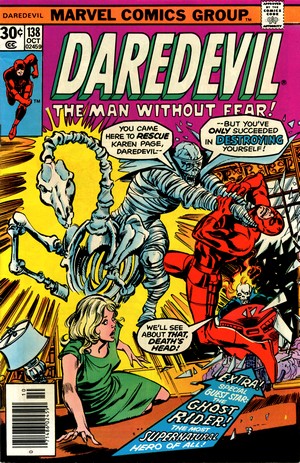
|
|
DAREDEVIL #138
October
1976
(monthly)
On Sale:
6 July 1976
Editor - Marv
Wolfman
Cover - Gene Colan (pencils)
& Tom Palmer (inks)
"Where
is Karen Page?"
(17 pages)
Story
- Marv Wolfman
Pencils - John Byrne
Inks - Jim Mooney
Lettering -
Joe Rosen
Colouring - Michele Wolfman
STORY
OVERVIEW
- Daredevil
is in Los Angeles looking for a
kidnapped Karen Page and clashes
with Death's-Head and the
Smasher. Meanwhile, Johnny Blaze
is after Stuntmaster who he's
learned has kidnapped Karen Page,
and as Daredevil is struggling,
Ghost Rider roars in to help the
Man without fear...
The story continues from
Ghost Rider #19 and concludes in
Ghost Rider #20.
|
|
|
|
| |
| From time to time a Marvel title
would feature a story which would be concluded in
a different title (and which possibly even
started in a different title, such as is the case
here). More often than not, this procedure -
which commonly served the purpose of giving one
of the two titles a shot in the arm as far as
sales were concerned - was a nuisance, since
there was a fair chance that your local sales
point might not carry that other title. It was,
of course, totally hopeless for buyers of MARVEL MULTI-MAGS, since the
chances of finding that "other title"
in a three-pack bordered on zero. Which meant the
only thing to do was to enjoy what you had as an
episodic interlude.
Interestingly enough, there is no editorial
information as to the fact that this story
started out in Ghost Rider #19, but as
is typical for a mid-1970s Marvel comic book,
readers simply get pulled into the action
straight away, no matter what.
|
|
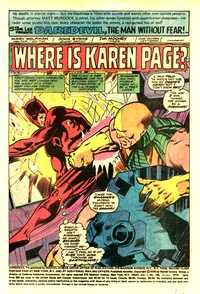 |
|
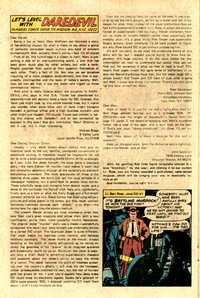 |
|
| |

|
|
In this case, it
is fair to assume that the title
in need of some additional
readers was the bi-monthly Ghost
Rider, and editorial would
be hoping for a few Daredevil
readers picking up that title too
so that they would learn how the
story ended. |
|
|
|
| |
|
| |
| |
|
| |
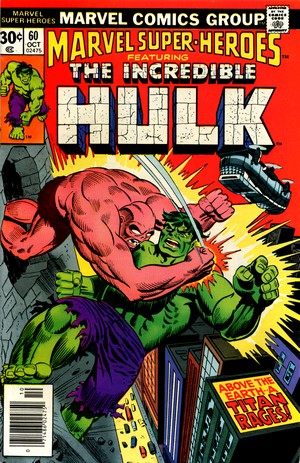
|
|
MARVEL
SUPER-HEROES #60
October
1976
(published 7 times a year)
On Sale:
13 July 1976
Reprint Editors -
Archie Goodwin, Richard Stern
Cover - Marie Severin (pencils)
& Frank Giacoia (inks)
"Above
the Earth - A Titan Rages!"
(18 pages)
Story - Archie
Goodwin (pages 1-9), Roy Thomas
(pages 10-18)
Pencils - Marie Severin
(Layouts), Herb Trimpe
Inks - George Tuska
Lettering -
Artie Simek
Originally published in - Incredible
Hulk #106 (August 1968),
minus 2 pages (4, 13)
STORY
OVERVIEW
- The
Hulk battles it out with the
Missing Link and is sucked into a
Cold War stand-off between a
S.H.I.E.L.D. heli-carrier and a
similar Russian device.
|
|
|
|
| |
| Marvel Comics had set up reprint titles almost as
soon as their very first superheroes became smash hits,
and as mentioned earlier, they proved rather popular
since they allowed fans to read "classic"
material which otherwise would be hard or outright
impossible to come by - since this was way before the
concept of the "collected edition" was even
thought of. Publisher Martin Goodman's business
experience from reprinting paperbacks in the 1940s and
Stan Lee's skill at selling just about anything connected
to Marvel combined to form a winning formula for all
sides involved (with the notable exception of the
artists, who stood to gain absolutely nothing from having
their work reprinted).
|
| |
| Marvel Super-Heroes was,
in fact, Marvel's very first regular reprint
title (i.e which wasn't an annual), starting out
as Fantasy
Masterpieces and launched in February
1966. Originally reprinting only horror and
sci-fi material from Marvel's pre-superhero age (hyped by Stan Lee as a "nostalgic
journey to yesterday's fantasy wonderland"),
it changed its title to
Marvel
Super-Heroes (while keeping the numbering)
as of issue #12
in December 1967 and featured a mix of new
material alongside reprints. Hosting a changing
array of new characters or known ones who were
given the spotlight in a giant-sized format of 68
pages backed up by reprint material, Marvel
Super-Heroes converted to the standard page
count size as of issue #32 in September 1972 and
also switched from featuring Iron Man and
Daredevil to the Hulk and the Sub-Mariner as its
"reprint feature" (which was possible
as the original source material used were the
shorter Hulk and Namor stories from back in the
days when they shared the pages of Tales To
Astonish). It was never, however, a complete
consecutive run of reprints, with a number of
issues being left out.
As of Marvel Super-Heroes #56 (March
1976), the Sub-Mariner reprints were dropped and
the title became an exclusive Hulk reprint book
as the source material had reached the point
where the Green Giant had branched out into his
own title, resulting in longer stories - with in
fact more pages than Marvel offered in 1976,
resulting in the omission of 1 or 2 pages of the
original material.
|
|
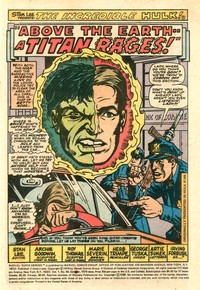 |
|
| |
 |
|
Several issues of
Marvel Super-Heroes were
packaged into MARVEL
MULTI-MAGS between
1976
and 1981, making the Hulk a
frequent feature of the MARVEL
MULTI-MAGS both in
his ongoing and his reprint
title. |
|
|
|
| |
| |
|
| |
| |
 |
|
Today,
any MARVEL MULTI-MAGS is a time
capsule; opening this plastic bag
right here offers a nostalgic
glimpse into what it was like to
be a comic book reader in October
1976. So what else was
going on back then?
|
|
|
|
|
|
 |
|
The US
Billboard Chart saw three
number 1s during October
1976: Walter
Murphy and the Big Apple
Band with "A Fifth
of Beethoven" as
well as Chicago with
"If you leave me
now" for one week
each, while Rick Dees and
His Cast of Idiots got
two weeks at the top with
"Disco Duck (Part
1)". In the
UK, ABBA with
"Dancing Queen"
and Pussycat with "Mississippi"
topped the charts for two
weeks each - clearly not
reflecting at all the
fact that 1976 was the
year that Punk Rock
exploded onto the British
music scene. |
|
|
|
|
|
 |
|
The New
York Times Bestseller
list for October 1976 was
topped by Leon Uris's
"Trinity", a
spot he occupied since
June; by the end of
October, however, the
number one position would
go to Agatha Christie's
posthumously published
last Miss Marple book,
"Sleeping
Murder".. |
|
|
|
|
|
|
 |
|
In
October 1976 John
Schlesinger's
"Marathon Man"
was the most popular
movie in the US. Overall,
"Rocky" was the
US top-grossing movie
while "Jaws"
(which had been released
in 1975 in the States)
topped the 1976 list in
the UK. |
|
|
|
|
|
|
 |
|
In the
US, all of the three most
popular TV shows came
from ABC, with
"Happy Days"
taking the top spot.
Numbers for the UK are
sketchy, but it appears
that the TV premiere of
James Bond's
"Goldfinger"
got the most viewers to
sit down in front of the
telly. |
|
|
|
|
|
|
| |
|
|
| |
| FURTHER
READING ON THE THOUGHT
BALLOON |
| |
| |
 |
|
"Comic
packs" not only sold well
for more than two decades, they
also offer some interesting
insight into the comic book
industry's history from the 1960s
through to the 1990s. There's
more on their general history here. |
|
|
|
| |
 |
|
There's more on
the background and the history of
the Marvel Multi Mags here. |
|
|
|
| |
 |
|
There's more
background information and
discussion of the "yellow
and green on white (3 comics for
89¢)" label MARVEL MULTI-MAGS here. |
|
|
|
| |
 |
|
There's more
background information and
discussion of Marvel's 1960s
reprint titles (and how and why
they became such a successful
venture for the House of Ideas) here. |
|
|
|
| |
| |
|
| |
| BIBLIOGRAPHY |
| |
| |
|
| |
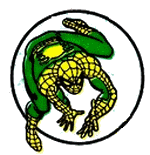
|
| |
|
| |

(c) 2021
uploaded
to the web 27 September 2021
|
| |
|
| |
|



















